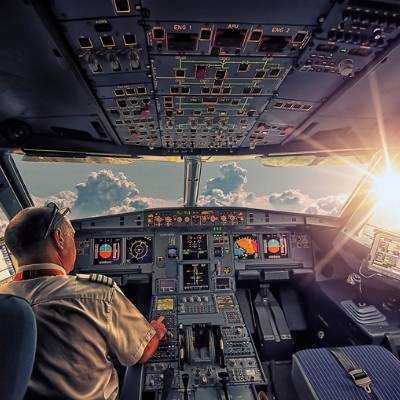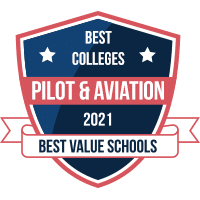
Pilot schools, flight training, and aviation education are all under the same umbrella but have specializations that will lead to different outcomes. The aviation degree with flight emphasis or specific pilot school will be a degree that will enable a student to legally operate aircraft. Over the next 20 years the airline industry is expecting to see shortages in qualified pilots and mechanics; to draw interested students airlines have partnered with colleges to bolster the flight programs.
Airlines are partnering with colleges by offering a pathway program that awards students with scholarships while they are in school and then grants them a position upon graduating.
This guarantee of employment and a way for them to earn the required hours to become certified makes it much more inviting and affordable colleges for students to remain in an aviation program.
A paved pathway that enables them to earn their flight hours makes their certification more likely and hence better ensures they become fully prepared and certified to pilot private or commercial aircraft.
Those that graduate with a bachelor’s degree in aviation benefit from needing only 1,000 flight hours to qualify to fly commercially. Whereas those without an aviation degree need1,500 flight hours. Students that hold a degree are also able to be flight instructors, which enables them more opportunities to complete more flight hours. Those that hold an associate degree in aviation will need 1,250 flight hours before they can qualify for certification.
Currently, the salary for commercial airline pilots is a minimum of $112K per year. With more airlines partnering with colleges with pathway programs to support student success and employment upon graduation, now is the ideal time for those dreaming of flying.
The Best Pilot Schools
Purdue School of Aviation and Technology
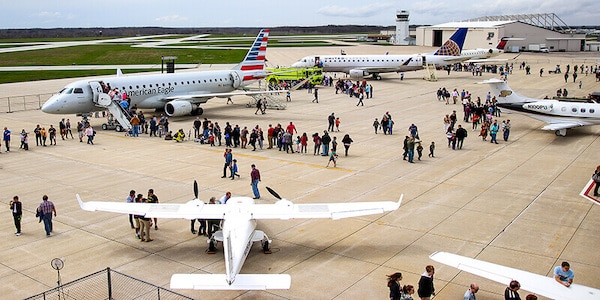
A public research university, Purdue University is home to a top-ranked School of Aviation and Technology. The professional flight program is fully accredited by the Aviation Accreditation Board International. Now offering state of the art flight simulators that prepare students with hours of flight practice to hone their analytical skills and critical thinking skill while in the cockpit, Purdue prepares students for a career as a commercial, corporate or charter pilot. Students earn a bachelor’s degree that provides them with a broad base of knowledge in the aviation industry, an understanding of aviation as part of a transportation system, and a complete comprehension of related technical fields.
School Overview
University of North Dakota Department of Aviation
The world’s most comprehensive aerospace university, University of North Dakota prepares students with a liberal arts core curriculum coupled with professional aviation education. Students enrolled in the John D. Odegard School of Aerospace Sciences have numerous specialties in aviation to choose from, with aviation management and commercial aviation being among the top-ranked programs and second-largest degree-granting school at UND. Internationally known for its aviation program, aerospace research, space studies, and policy research, UND certainly stands out as an institution for those seeking to enroll in pilot school.
School Overview
Embry – Riddle Aeronautical University
As a pioneer in aviation education, Embry-Riddle Aeronautical University is among the most highly regarded institutions dedicated to the study of flight. Embry-Riddle is the oldest and most comprehensive aeronautical university.
Students benefit from receiving the most current national and international aviation education with the most up to date research and policies that affect their field of study. Embry-Riddle is heavily involved as a participant in such research and policymaking. Students are well accommodated with traditional on-campus educational learning methods as well as online and hybrid methods of instruction as well. Embry-Riddle accommodates working professionals and military personnel with their schedules to ensure all students desiring an education in aviation are given the opportunities and learning methods to receive that education.
School Overview
Lewis University
Lewis University is near Chicago which means it is also near the headquarters for United Airlines, Boeing Corporation and one of the busiest airports in the world, O’Hare International.
Simply the location lends unlimited opportunities for students of aviation that they could not experience elsewhere. Students are immersed in the aviation industry with O’Hare International airport as well as a regional airport right on the campus of Lewis University. Students learn with premier flight instruction, an extensive aircraft fleet, and numerous networking opportunities. Students of Lewis University’s aviation program are often time recruited before they are graduated.
School Overview
Ohio State University’s Center for Aviation Studies
Founded in 1870, Ohio State University began training a handful of pilots in 1917 during World War I. The original program was dormant until the need arose again to train civilian pilots which quickly became linked to the World War II effort. The schools of aviation officially had civilian programs in 1945. Currently, Ohio State University has the third busiest airport in the state of Ohio with students logging more than 7,000 fleet training hours per year. The Center for Aviation Studies is fully accredited by the AABI and continues to be a leader in aviation studies.
School Overview
Western Michigan University
Western Michigan University has been training pilots for over 80 years. They have a vision to establish and maintain the most advanced training fleet and equipment available in collegiate aviation coupled with advancing the academic and educational programs to be the most comprehensive globally. Graduates are prepared academically with critical communication skills, the ability to think critically and perform ethically in their field. Job placement in their field of choice upon graduation is 97% on average (100% placement in flight and tech ops) for 2018-19, one of the highest in the nation. With 50 aircraft for a student to train in and receive flight hours, graduates can certify much sooner after graduation.
WMU offers three aviation degrees: aviation flight science (a professional pilot program), aviation management and operations (focusing on the business side of aviation), and aviation technical operations (qualifying the person to obtain their airframe and powerplant certification). WMU is one of three programs in the country to partner with both the Delta Propel and United Aviate program. In addition, they have partnerships and hiring opportunities with Envoy, SkyWest, Endeavor, Republic, Air Wisconsin, Mesa, etc.
School Overview
The United States Air Force Academy
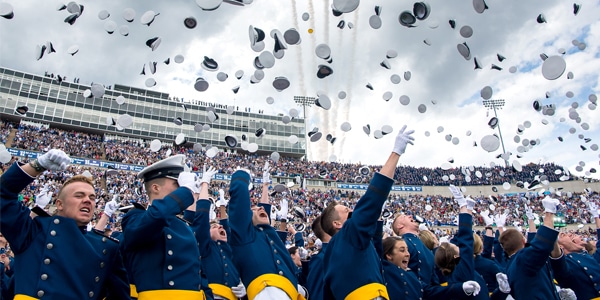
With a history of excellence and a focus on the future, the United States Air Force Academy instills cadets with pride and integrity while preparing them to serve their country and succeed in 21st-century careers. As a public university and a military service academy, we are leading the way into an increasingly complex future, driving advancement and innovation in air, space and cyberspace, among countless other fields.
Whether you come to Colorado Springs for the world-class education, military training, the leading undergraduate research programs, Division I athletics, or character-building challenge and adventure, one thing is certain, the Academy experience—more than 60 years in the making—is unlike any other.
A core part of the United States Air Force Academy experience involves flying with our Airmanship Programs. From instruction in concepts of flight, navigation and operations to real-life application of these principles via soaring, powered flight and parachuting courses, there are no shortage of opportunities to experience a different altitude for 2,500 cadets each year.
School Overview
Baylor University
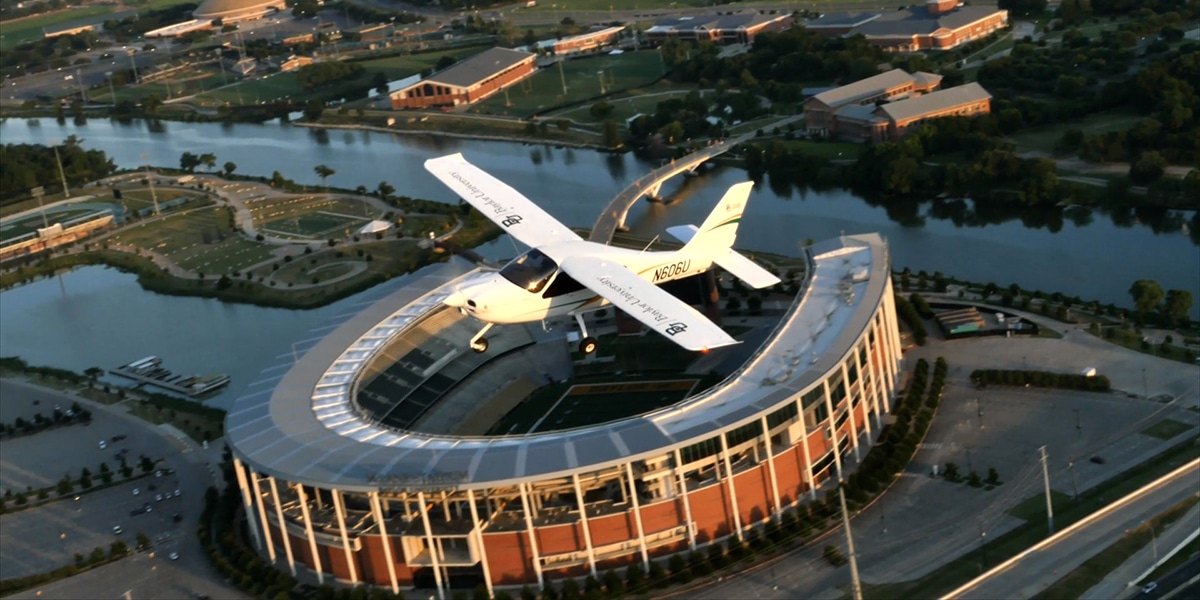
Baylor University is the perfect choice for any student who is focused on a career in the aviation industry. Students enjoy the excitement of a vibrant campus life at a Big 12 university while receiving an outstanding college education in a faith-based community.
For students whose ultimate goal is to fly professionally, the Aviation Sciences Major will get you there! With the Professional Pilot concentration – Airplane or Helicopter option, students will earn valuable flight experience as part of their degree plan and are exposed to industry professionals with a serious passion for their work. Graduates from the program will be set up for success having completed all of the needed certifications and ratings to become an airline or corporate pilot.
School Overview
Utah Valley University
Utah Valley University offers a professional pilot degree both on-campus and online. For students that complete the degree online, they can earn their necessary flight hours at any FAA-approved flight school in the nation. Those attending on-campus earn their flight hours at a nearby FAA approved airport. UVU also offers many pathway programs to students through their numerous partnerships with airlines. These airline partnerships assist students and graduates with a clear career path through college and upon graduation. Students also benefit from aviation clubs.
School Overview
Saint Louis University
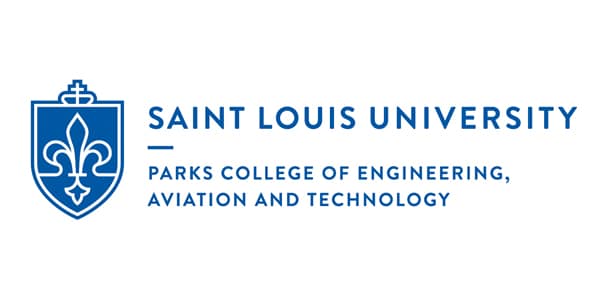
As America’s first federally certified school of aviation, Saint Louis University’s Parks College of Engineering, Aviation and Technology has been a pioneer in the aviation industry. With innovative technology and engineering, Parks College has been at the forefront of the development of robots to rockets. Students enrolled in the flight program will be adding flight hours to their resume as early as their freshman year, with more as they continue with their bachelor’s degree program. Parks College is student-focused and drives students to successful careers while maintaining the Jesuit values of Saint Louis University.
School Overview
LeTourneau University
LeTourneau University is the only university in Texas that awards aviation degrees at the undergraduate and graduate levels. Another distinguishing factor that sets LeTourneau apart is that all of the aviation education is given by expert faculty members, from in-class academics to flight instructors to aircraft maintenance. None of the education is delivered through third-party constituents. Of the graduates of the pilot program, 100% received employment in their given field within 1 year of graduation. The flight simulators and other facilities for training are state of the art and allow for exceptional experience and training.
School Overview
Louisiana Tech University
Since 1967, Louisiana Tech University has had an outstanding aviation program that graduates professional pilots and others in the field of aviation. The Department of Professional Aviation is fully accredited by Aviation Accreditation Board International and is a member of the University of Aviation Association. Louisiana Tech offers partnerships with airlines that allow students to participate in internships with major air carriers and regional airlines. Graduates are equipped with the knowledge, skills, and attitude to succeed and become aviation leaders in their careers.
School Overview
Methodology
If you are looking to take to the skies, quite literally, with your education, browse the Pilot schools and aeronautics programs that are available around the country and enroll in the best program for you. As the demand for highly trained and qualified pilots is set to increase over the next 20 years, now is the time to enroll in pilot school to have a high paying and rewarding career tomorrow.
Schools were ranked according to a matrix of cost, job placement upon graduation, opportunities for flight hours, and partnerships with pathway programs.
Schools were ranked according to a matrix of cost, program availability, and delivery methods. If you have any questions, please feel free to reach out and contact us.
Is a Pilot School Right for You?
Deciding if a pilot school or aviation college is the right choice involves several key considerations. Prospective students should assess their interest and aptitude in aviation, understanding that this field requires a strong foundation in science, mathematics, and technology. It’s also important to consider the physical and mental demands of a career in aviation, including the ability to handle high-pressure situations and irregular work hours.
Financial investment is another crucial factor. Pilot training and aviation programs can be costly, so understanding the financial commitment and exploring potential financial aid is important.
Future career aspirations play a pivotal role in this decision. While many aspire to become commercial pilots, aviation careers are diverse, including roles in air traffic control, aircraft maintenance, and aerospace engineering.
Lastly, consider the lifestyle implications, such as the possibility of frequent travel and time away from home, which are inherent to many aviation careers. Balancing these factors with personal goals and interests is key to determining if an aviation-focused education is the right path.
Do I Need Flying Experience Before Attending Flying School?
It’s a common question whether prior flying experience is necessary before enrolling in a flying school. The answer largely depends on the specific requirements of the school and the program. Generally, no prior flying experience is required for entry-level pilot training programs. These schools are designed to teach you everything from the basics. However, having some experience can be beneficial and might make the learning process smoother. It’s always a good idea to check with the specific school for any prerequisites or recommended experience before applying.
Prerequisites for Pilot Schools in the USA
Enrolling in a pilot school in the United States typically involves meeting certain prerequisites. These usually include:
- Age Requirements: Minimum age limits apply, often 17 years for private pilot training and 18 for commercial pilot training.
- Educational Background: A high school diploma or equivalent is generally required, with a focus on subjects like mathematics and physics.
- Medical Certification: Obtaining an FAA medical certificate is crucial to ensure you meet the health and fitness standards for flying.
- English Proficiency: As English is the international language of aviation, proficiency is necessary for both domestic and international communication.
- Background Checks: For security reasons, background checks are standard procedure in aviation training.
These prerequisites ensure that students are prepared for the rigors and responsibilities of pilot training.
How Long Is Pilot School?
Pilot school is a lengthy program that can take up to two years, depending on the type of license an aspiring pilot is seeking. Fully-fledged aeronautics degrees (undergraduate) can take up to four years. For a commercial pilot license, the process typically involves obtaining at least 250 hours of flight time and requires knowledge in areas such as aircraft performance, instrument training, navigation systems, aviation weather systems, and more.
To receive an Airline Transport Pilot (ATP) certificate, which is required for passengers to fly, even more schooling and flight experience are needed. An ATP certification requires 1500 flight hours, including an advanced ground school course. It should be noted, however, that these requirements may vary depending on local regulations and the country an aspiring pilot is getting their certification in.
Average Cost of Pilot School
The cost of pilot school can vary widely depending on the type of training, the institution, and the geographic location. For basic private pilot licenses, costs can range from $8,000 to $15,000, while obtaining a commercial pilot license might range from $70,000 to $100,000 or more, encompassing all required flight hours and training. Advanced training for specific aircraft or additional certifications will add to these costs. It’s important for students to consider not only tuition but also additional expenses such as equipment, uniforms, and examination fees when budgeting for their education. Prospective students should research and compare programs to find the best fit for their budget and career goals.
Is There Financial Aid Available for Flight School?
Yes, financial aid is often available for students attending flight school, though it varies by institution and program. This can include traditional federal student loans, scholarships, grants, and work-study programs. Some flight schools also offer specific financing options for their students. Additionally, veterans may be eligible for benefits under the GI Bill. It’s important for prospective students to research and consult with financial aid offices at their chosen schools to understand the options and eligibility criteria for financial assistance.
Common Pilot School Courses
Being a pilot is no easy feat and requires extensive training to become certified. Pilot School courses are designed to give aspiring pilots the knowledge, skills, and confidence needed to succeed in the field.
In this section, we’ll discuss common pilot school courses and what topics comprise them. From aviation principles to flight simulators and more, a student’s course load in pilot school must provide a complete range of experience that can be applied in the field.
Courses Pilots can be Expected to Complete:
- Airspace & Flight Rules: Students gain a thorough understanding of the rules and regulations governing airspace, both national and international. This course will also cover flight plans, communication procedures, and key safety protocols for aircraft.
- Aircraft Systems: This course explores the components and the systems that work together to ensure an aircraft functions properly. Pilots will become familiar with engine systems, hydraulics, pneumatics, and avionics.
- Navigation: Pilots learn how to use instruments to help them successfully navigate their aircraft while in flight. This course covers map reading, airspace, plotting courses, and dead reckoning.
- Weather: This subject is essential for pilots to safely fly and navigate their aircraft, as well as predict upcoming weather conditions. In this course, students learn how to read weather maps and interpret data, as well as determine potential threats based on the weather.
- Performance & Flight Training: By the end of this course, pilots should be fully prepared to take off and land a plane with confidence. They’ll learn the basics of operating an aircraft from a cockpit, practice aircraft maneuvers and procedures, as well as practice common emergencies.
- Aircraft Mechanics & Maintenance: Students will learn about aircraft and how to maintain them. This course covers topics such as understanding parts, lubricating systems, inspecting planes for defects, troubleshooting issues, and repairing components.
Do I Earn My Pilot License After Pilot School?
To become a licensed pilot, an individual must complete a rigorous training program. This typically involves attending a flight school, which offers a range of courses designed to help students acquire the necessary skills and qualifications required to become a professional pilot. After completing the prescribed coursework and obtaining satisfactory scores on exams, a student can apply to take their practical flight test to receive their license.
Once they have successfully passed the test, they can begin flying independently under the jurisdiction of the applicable civil aviation authority. Further instruction or additional experience may be required before a student is certified to fly commercially
Additionally, pilots must regularly pass medical exams that determine their fitness for air travel to maintain their current licenses.
Pilot Salary and Career Outlook
Pilots are highly-skilled professionals who command a high salary in exchange for their expertise and experience. Pilot salaries vary depending on a number of factors, including employer, experience level, and aircraft type. According to the BLS, the median annual pay for airline and commercial pilots is $148,900, as of May 2022.
The career outlook for pilots is solid. Employment of airline and commercial pilots is projected to grow 4% from 2022 to 2032, which is about as fast as the average for all occupations, according to the BLS.
How to Become a Commercial Pilot
If you have a passion for the skies and the thrill of flying, then becoming a commercial pilot may be the perfect career for you. Turning your dream into a reality requires dedication, hard work, and a clear-cut plan that will ensure success.
In this section, you’ll explore the requirements and steps needed to become a commercial pilot.
Step 1: Acquire your Private Pilot License
This is the first step to becoming a commercial pilot. You need to be at least 16 years old and have a minimum of 40 hours of flight experience. This will include both ground and flying instruction. You will also need to pass various FAA exams and aviation studies.
Step 2: Earn your Instrument Rating
After obtaining your Private Pilot License, the next step would be to obtain your Instrument Rating. This will enable you to fly under instrument flight rules and give you the ability to fly in more demanding conditions. To obtain this rating, you will need at least 40 hours of actual or simulated instrument flight training, 50 hours of cross-country flight time as the pilot in command (with at least 10 hours in airplanes suitable for an instrument-airplane rating), 15 hours of instrument flight training from authorized instructors, and pass the relevant FAA exams.
Step 3: Obtain your Commercial Pilot License
To obtain this license, you will need a minimum of 250 hours of flight experience, as well as pass another set of FAA exams.
Step 4: Gain Additional Flight Experience
To be accepted for a job as a commercial pilot with an ATP certification, you must have over 1500 hours of total flight experience. To gain this experience, you can take flying jobs or internships and build up your hours.
Step 5: Get a Job in the Aviation Industry
After gaining enough experience and becoming a fully-fledged commercial pilot, you can start looking for jobs. Airlines, aerial photography firms, and freight companies are always looking for experienced pilots.
Where Do Commercial Pilots Work?
Commercial pilots work in a variety of settings. Pilots can fly for airlines, cargo companies, as private charter pilots, or as corporate/executive jet pilots. All of these settings offer unique opportunities and experiences for pilots.
Airline pilots will fly passengers and cargo to their destinations with their crew in an airline-owned aircraft. Cargo pilots will transport items such as mail, food, and medical supplies while traveling worldwide.
Private charter pilots fly smaller planes and serve clients on demand, taking them to their desired locations on time, and corporate/executive jet pilots are responsible for safely transporting high-profile clients in jets designed with luxury appointments and special amenities.
Pilots who wish to expand their experience have multiple career paths after obtaining their commercial license. They can become flight instructors and assist in teaching others proper aviation techniques.

